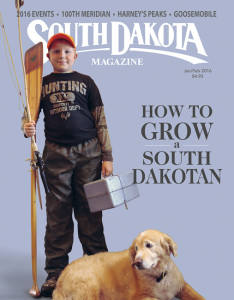
by Katie Hunhoff
How do you grow a South Dakotan? We all want the children in our lives to grow up with a sense of place and pride. But nobody has ever published a “how to” guide on accomplishing such a goal.
Our magazine staff began the task by recalling our own childhood experiences. Then we asked experts (anglers, cowboys, artists, rock hounds and a rattlesnake professor) to help. The result is a guide for parents, grandparents, aunts, uncles, teachers and all adults who play important roles in young South Dakotans’ lives.
Much of the guide involves ways to involve children with nature. We offer advice on best hikes, rock hunting, rattlesnake etiquette, and guides on how to identify South Dakota fish, trees and the most common cattle breeds.
Joel Vasek, a popular fishing guide from Geddes, tells how he engages children on a fishing trip. “Get them involved in some of the decisions,” he suggests. “We can catch fish on anything, so let them look through the tackle box and pick out a few lures. I also make sure the live well is accessible to them, and then I’ll ask them to check on the fish now and then.”
Are you familiar with our state song, Hail South Dakota? That’s one of several cultural pieces we suggest are important to raising a South Dakotan. The song was written by DeeCort Hammitt of Alcester and adopted in 1947. He was the first director of the Alcester town band that performed for President Calvin Coolidge during his Black Hills vacation in 1927.
We also recommend a reading list for all ages of young readers, and a compilation of art museums where they’ll find some of the most important works South Dakotans have created. And of course we suggest that kids learn about Badger Clark, our state’s first poet laureate who wrote the beloved poem “A Cowboy’s Prayer.”
We also solicited suggestions from the Reinhold family of Sturgis, operators of Rainbow Bible Ranch; Suzanne Hegg, the first executive director of the Children’s Museum in Brookings; and Steve Van Bockern, an education professor at Augustana University in Sioux Falls.
And we visited with Marla Bull Bear, director of the Native American Advocacy Program that hosts summer camps for youth at Milk’s Camp in Gregory County. Marla uses stories about nature to teach life lessons. At a recent camp, she and camp participants spooked a blue heron while taking a walk. That prompted her to tell the group a story of a heron that forgot it was a migratory bird. “It didn’t know its own history and forgot who it was,” she said. “It thought it could be a winter bird, but when the cold weather came it nearly froze to death because it was too proud and refused help.”
Like blue herons, it’s important for our youngsters to know their place. Our guide is a good start.
Katie Hunhoff is the editor of South Dakota Magazine, a print magazine that features the people and places of our great state. To subscribe or to order the current issue discussed above, visit www.SouthDakotaMagazine.com


